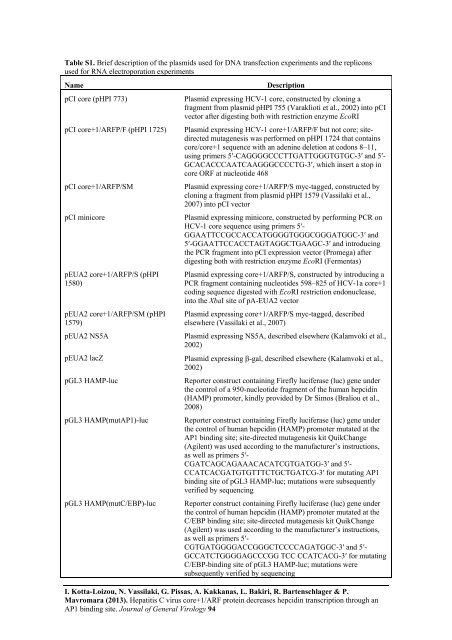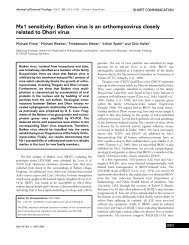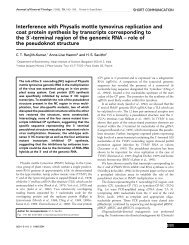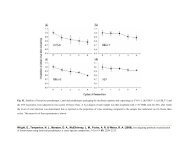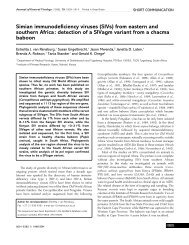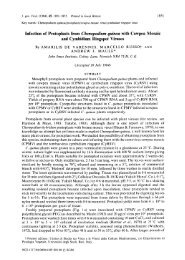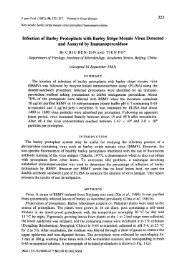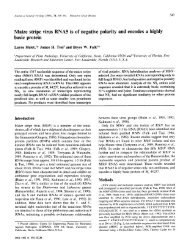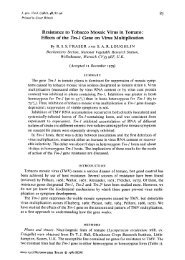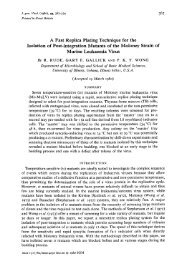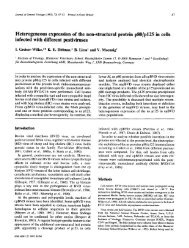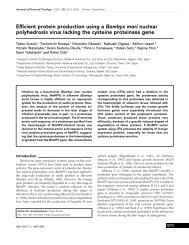Supplementary material - Journal of General Virology
Supplementary material - Journal of General Virology
Supplementary material - Journal of General Virology
You also want an ePaper? Increase the reach of your titles
YUMPU automatically turns print PDFs into web optimized ePapers that Google loves.
Table S1. Brief description <strong>of</strong> the plasmids used for DNA transfection experiments and the replicons<br />
used for RNA electroporation experiments<br />
Name<br />
Description<br />
pCI core (pHPI 773)<br />
Plasmid expressing HCV-1 core, constructed by cloning a<br />
fragment from plasmid pHPI 755 (Varaklioti et al., 2002) into pCI<br />
vector after digesting both with restriction enzyme EcoRI<br />
pCI core+1/ARFP/F (pHPI 1725)<br />
pCI core+1/ARFP/SM<br />
pCI minicore<br />
pEUA2 core+1/ARFP/S (pHPI<br />
1580)<br />
pEUA2 core+1/ARFP/SM (pHPI<br />
1579)<br />
pEUA2 NS5A<br />
pEUA2 lacZ<br />
pGL3 HAMP-luc<br />
pGL3 HAMP(mutAP1)-luc<br />
pGL3 HAMP(mutC/EBP)-luc<br />
Plasmid expressing HCV-1 core+1/ARFP/F but not core; sitedirected<br />
mutagenesis was performed on pHPI 1724 that contains<br />
core/core+1 sequence with an adenine deletion at codons 8–11,<br />
using primers 5′-CAGGGGCCCTTGATTGGGTGTGC-3′ and 5′-<br />
GCACACCCAATCAAGGGCCCCTG-3′, which insert a stop in<br />
core ORF at nucleotide 468<br />
Plasmid expressing core+1/ARFP/S myc-tagged, constructed by<br />
cloning a fragment from plasmid pHPI 1579 (Vassilaki et al.,<br />
2007) into pCI vector<br />
Plasmid expressing minicore, constructed by performing PCR on<br />
HCV-1 core sequence using primers 5′-<br />
GGAATTCCGCCACCATGGGGTGGGCGGGATGGC-3′ and<br />
5′-GGAATTCCACCTAGTAGGCTGAAGC-3′ and introducing<br />
the PCR fragment into pCI expression vector (Promega) after<br />
digesting both with restriction enzyme EcoRI (Fermentas)<br />
Plasmid expressing core+1/ARFP/S, constructed by introducing a<br />
PCR fragment containing nucleotides 598–825 <strong>of</strong> HCV-1a core+1<br />
coding sequence digested with EcoRI restriction endonuclease,<br />
into the XbaI site <strong>of</strong> pA-EUA2 vector<br />
Plasmid expressing core+1/ARFP/S myc-tagged, described<br />
elsewhere (Vassilaki et al., 2007)<br />
Plasmid expressing NS5A, described elsewhere (Kalamvoki et al.,<br />
2002)<br />
Plasmid expressing -gal, described elsewhere (Kalamvoki et al.,<br />
2002)<br />
Reporter construct containing Firefly luciferase (luc) gene under<br />
the control <strong>of</strong> a 950-nucleotide fragment <strong>of</strong> the human hepcidin<br />
(HAMP) promoter, kindly provided by Dr Simos (Braliou et al.,<br />
2008)<br />
Reporter construct containing Firefly luciferase (luc) gene under<br />
the control <strong>of</strong> human hepcidin (HAMP) promoter mutated at the<br />
AP1 binding site; site-directed mutagenesis kit QuikChange<br />
(Agilent) was used according to the manufacturer’s instructions,<br />
as well as primers 5′-<br />
CGATCAGCAGAAACACATCGTGATGG-3′ and 5′-<br />
CCATCACGATGTGTTTCTGCTGATCG-3′ for mutating AP1<br />
binding site <strong>of</strong> pGL3 HAMP-luc; mutations were subsequently<br />
verified by sequencing<br />
Reporter construct containing Firefly luciferase (luc) gene under<br />
the control <strong>of</strong> human hepcidin (HAMP) promoter mutated at the<br />
C/EBP binding site; site-directed mutagenesis kit QuikChange<br />
(Agilent) was used according to the manufacturer’s instructions,<br />
as well as primers 5′-<br />
CGTGATGGGGACCGGGCTCCCCAGATGGC-3′ and 5′-<br />
GCCATCTGGGGAGCCCGG TCC CCATCACG-3′ for mutating<br />
C/EBP-binding site <strong>of</strong> pGL3 HAMP-luc; mutations were<br />
subsequently verified by sequencing<br />
I. Kotta-Loizou, N. Vassilaki, G. Pissas, A. Kakkanas, L. Bakiri, R. Bartenschlager & P.<br />
Mavromara (2013). Hepatitis C virus core+1/ARF protein decreases hepcidin transcription through an<br />
AP1 binding site. <strong>Journal</strong> <strong>of</strong> <strong>General</strong> <strong>Virology</strong> 94
pGL3 HAMP(mutSTAT3)-luc<br />
eEF1-luc (pHPI 8101)<br />
AP1-luc<br />
pCG c-jun~c-fos<br />
pCG Jun<br />
I389-Luc-ub-EI-JFH1NS3-3'<br />
I389-Luc-ub-H77core-EI-<br />
JFH1NS3-3'<br />
I389-Luc-ub-H77core+1/ARFP/S-<br />
EI-JFH1NS3-3'<br />
Reporter construct containing Firefly luciferase (luc) gene under<br />
the control <strong>of</strong> human hepcidin (HAMP) promoter mutated at the<br />
STAT3 binding site; site-directed mutagenesis kit QuikChange<br />
(Agilent) was used according to the manufacturer’s instructions,<br />
as well as primers 5′-<br />
CGGCGCCACCACCGGATTGGAAATGAG-3′ and 5′-<br />
CTCATTTCCAATCCGGTGGTGGCGCCG-3′ for mutating<br />
STAT3-binding site <strong>of</strong> pGL3 HAMP-luc; mutations were<br />
subsequently verified by sequencing<br />
Reporter construct containing the Firefly luciferase gene under the<br />
control <strong>of</strong> eukaryotic elongation factor 1; EagI fragment from<br />
pGEM-luc plasmid (Promega), containing the luciferase sequence,<br />
was inserted in the cloning site <strong>of</strong> pHPI 8098, which was derived<br />
from pHPI 8092 plasmid, by cloning the EF1 promoter sequence<br />
from pEF1/V5/His A plasmid (Invitrogen), after digesting both<br />
with MluI and NotI<br />
Reporter construct containing the Firefly luciferase gene under the<br />
control <strong>of</strong> a consensus AP-1 element, a kind gift from Dr Weiss<br />
(Shapiro et al., 1996)<br />
Plasmid expressing a single-chain AP1-tethered dimer (Bakiri et<br />
al., 2002).<br />
Plasmid expressing a dominant negative Jun protein (Bakiri et<br />
al., 2002)<br />
Bicistronic subgenomic reporter JFH1-based replicon composed<br />
<strong>of</strong> the JFH1 5' UTR, Firefly luciferase gene, ubiquitin gene, the<br />
EMCV IRES, the coding region <strong>of</strong> the JFH1 non-structural<br />
proteins NS3 to NS5B and the JFH1 3' UTR<br />
Bicistronic subgenomic reporter JFH1-based replicon composed<br />
<strong>of</strong> the JFH1 5' UTR, Firefly luciferase and ubiquitin genes fused<br />
in frame with core from isolate H77 (subtype 1a), the EMCV<br />
IRES, the coding region <strong>of</strong> the JFH1 nonstructural proteins NS3 to<br />
NS5B and the JFH1 3' UTR<br />
Bicistronic subgenomic reporter JFH1-based replicon composed<br />
<strong>of</strong> the JFH1 5' UTR, Firefly luciferase and ubiquitin genes fused<br />
in frame with core+1/ARFP/S from isolate H77 (subtype 1a), the<br />
EMCV IRES, the coding region <strong>of</strong> the JFH1 nonstructural<br />
proteins NS3 to NS5B and the JFH1 3' UTR<br />
I. Kotta-Loizou, N. Vassilaki, G. Pissas, A. Kakkanas, L. Bakiri, R. Bartenschlager & P.<br />
Mavromara (2013). Hepatitis C virus core+1/ARF protein decreases hepcidin transcription through an<br />
AP1 binding site. <strong>Journal</strong> <strong>of</strong> <strong>General</strong> <strong>Virology</strong> 94
Table S2. List <strong>of</strong> priming specific oligonucleotides used for RT-qPCR and RT-PCR<br />
Gene<br />
Primer<br />
CORE (F) 5′-GGAATTCCGCCACCATGGGGTGGGCGGGATGGC-3′<br />
CORE (R) 5′-GGAATTCCACCTAGTAGGCTGAAGC-3′<br />
FOS (F) 5′-CGGGCTTCAACGCAGACTA-3′<br />
FOS (R) 5′-GGTCCGTGCAGAAGTCCTG-3′<br />
HAMP (F) 5′-CTGACCAGTGGCTCTGTTTTC-3′<br />
HAMP (R) 5′-GAAGTGGGTGTCTCGCCTC-3′<br />
TFR2 (F) 5′-CTGCACTGGGTCGATGAGG-3′<br />
TFR2 (R) 5′-TCCTGAGCATTGGTCACCTTC-3′<br />
YWHAZ (F) 5′-CGCTGGTGATGACAAGAAAGG-3′<br />
YWHAZ (R) 5′-GGATGTGTTGGTTGCATTTCCT-3′<br />
I. Kotta-Loizou, N. Vassilaki, G. Pissas, A. Kakkanas, L. Bakiri, R. Bartenschlager & P.<br />
Mavromara (2013). Hepatitis C virus core+1/ARF protein decreases hepcidin transcription through an<br />
AP1 binding site. <strong>Journal</strong> <strong>of</strong> <strong>General</strong> <strong>Virology</strong> 94
Fig. S1. (a) Huh7 cells were transfected with core, core+1/ARFP/F, core+1/ARFP/S, core+1/ARFP/SM,<br />
minicore or NS5A expression vectors and Western blotting was performed (left panel). In the case <strong>of</strong><br />
minicore, due to lack <strong>of</strong> an appropriate antibody, total RNA was extracted and RT-PCR for minicore and<br />
a housekeeping gene, YWHAZ, was performed (middle panel). Huh7.5 cells were electroporated with<br />
replicons expressing core or core+1/ARFP/S and Western blotting was performed (right panel). (b)<br />
Firefly luciferase activity in Huh7 cells co-transfected with c-jun~c-fos expression vector, Jun<br />
expression vector and AP1-luc construct, 48 h p.t. (c) Firefly luciferase activity in Huh7 cells cotransfected<br />
with core or core+1/ARF expression vectors, c-jun~c-fos expression vector and HAMP-luc<br />
constructs, both the wild-type and the mutated at the AP1 binding site, 48 h p.t.<br />
References<br />
Bakiri, L., Matsuo, K., Wisniewska, M., Wagner, E. F. & Yaniv, M. (2002). Promoter specificity and<br />
biological activity <strong>of</strong> tethered AP-1 dimers. Mol Cell Biol 22, 4952–4964.<br />
doi:10.1128/MCB.22.13.4952-4964.2002 Medline<br />
Braliou et al. (2008).<br />
Kalamvoki et al. (2002).<br />
Shapiro, V. S., Mollenauer, M. N., Greene, W. C. & Weiss, A. (1996). c-rel regulation <strong>of</strong> IL-2 gene<br />
expression may be mediated through activation <strong>of</strong> AP-1. J Exp Med 184, 1663–1669.<br />
doi:10.1084/jem.184.5.1663 Medline<br />
Varaklioti, A., Vassilaki, N., Georgopoulou, U. & Mavromara, P. (2002). Alternate translation occurs<br />
within the core coding region <strong>of</strong> the hepatitis C viral genome. J Biol Chem 277, 17713–17721.<br />
doi:10.1074/jbc.M201722200 Medline<br />
Vassilaki, N., Boleti, H. & Mavromara, P. (2007). Expression studies <strong>of</strong> the core+1 protein <strong>of</strong> the<br />
hepatitis C virus 1a in mammalian cells. FEBS J 274, 4057–4074. doi:10.1111/j.1742-<br />
4658.2007.05929.x Medline<br />
I. Kotta-Loizou, N. Vassilaki, G. Pissas, A. Kakkanas, L. Bakiri, R. Bartenschlager & P.<br />
Mavromara (2013). Hepatitis C virus core+1/ARF protein decreases hepcidin transcription through an<br />
AP1 binding site. <strong>Journal</strong> <strong>of</strong> <strong>General</strong> <strong>Virology</strong> 94


